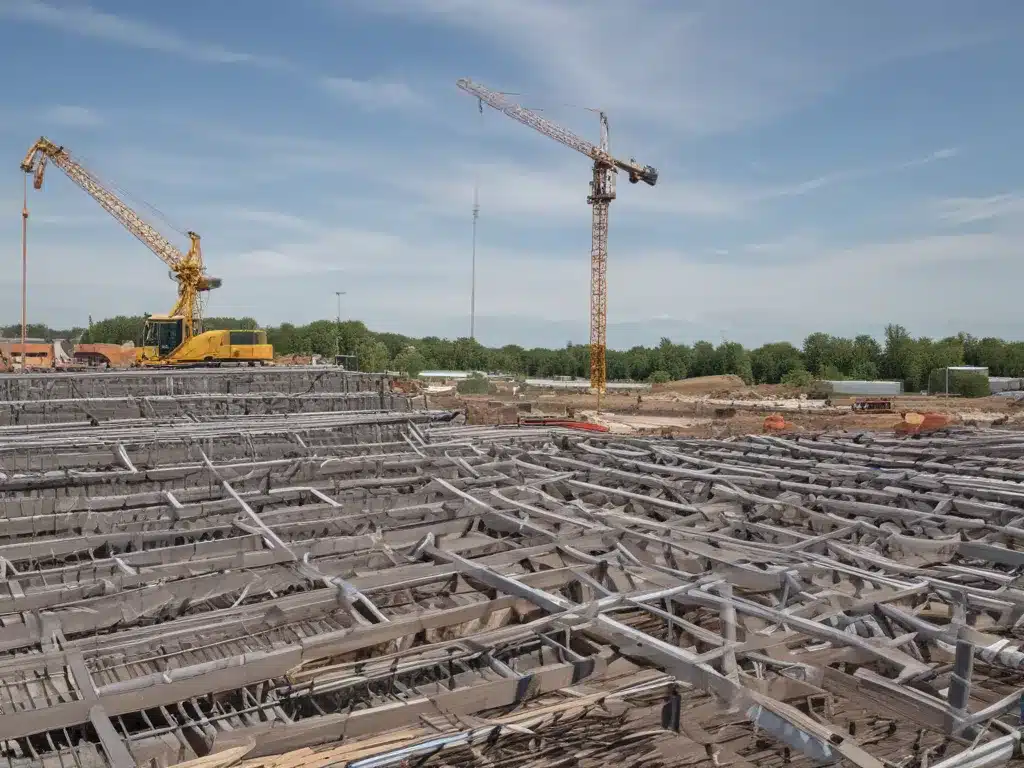
Climate Change and the Construction Industry’s Role
Greetings, earthlings! Are you concerned about our planet’s future? Well, you should be – climate change is no joke. And you know who plays a h̤u̲g̲e̲ role in this whole mess? The construction industry. Don’t get me wrong, I love buildings as much as the next person (okay, maybe a little more), but we can’t ignore the elephant in the room: construction has a massive carbon footprint.
Just how massive, you ask? Well, buckle up, because these numbers are about to blow your mind. The construction sector is responsible for a whopping 39% of global carbon emissions! That’s more than the entire transportation industry. Yikes!
But fear not, fellow earthlings, for there is hope. With some clever thinking and a bit of elbow grease, we can turn the construction industry into a lean, green, carbon-neutral machine. Intrigued? Then keep reading, because I’m about to take you on a wild ride through the world of sustainable construction.
What Does Carbon Neutral Mean?
Before we dive into the nitty-gritty, let’s get one thing straight: what the heck does “carbon neutral” even mean? Simply put, it’s when a company, industry, or activity releases net zero carbon emissions into the atmosphere.
Now, you might be thinking, “But doesn’t construction inherently release carbon? How can it be neutral?” Ah, grasshopper, allow me to explain.
The key is offsetting. For every ton of carbon dioxide (CO2) emitted during construction activities, an equivalent amount must be removed from the atmosphere through various carbon capture and storage methods. It’s like a cosmic game of tug-of-war, but with greenhouse gases instead of a rope.
So, while construction might never be truly zero emission, it can achieve neutrality by balancing its books, so to speak. And trust me, with the right strategies in place, it’s totally doable.
Strategies for Carbon Neutral Construction
Alright, enough chit-chat. Let’s get down to business and explore some of the strategies that can help the construction industry go carbon neutral.
1. Sustainable Material Choices
One of the biggest culprits behind construction’s carbon footprint is the production and transportation of building materials. But what if we could choose materials that are not only durable and cost-effective but also eco-friendly?
Enter sustainable materials like bamboo, recycled plastic, and even hempcrete (yes, that’s a thing). These materials have a significantly lower carbon footprint than traditional options like concrete and steel. Plus, they’re often locally sourced, reducing those pesky transportation emissions.
And let’s not forget about good ol’ timber. When responsibly harvested, wood is a renewable resource that actually sequesters carbon during its growth phase. Talk about a win-win!
2. Energy-Efficient Design and Construction
Remember that saying, “An ounce of prevention is worth a pound of cure”? Well, it applies to construction too. By designing and building energy-efficient structures from the get-go, we can drastically reduce their carbon footprint over their entire lifetime.
We’re talking about things like:
- Optimized building orientation for passive heating and cooling
- Highly insulated walls, floors, and roofs
- Energy-efficient windows and HVAC systems
- Integrating renewable energy sources like solar panels
It’s all about minimizing the amount of energy required to heat, cool, and power the building once it’s occupied. And trust me, those energy savings can really add up over time.
3. Lean Construction Practices
Ah, lean construction – the magical unicorn that promises to reduce waste, increase efficiency, and save us all from construction-induced carbon overload.
The basic idea is simple: by streamlining processes, eliminating unnecessary activities, and optimizing resource usage, we can minimize the carbon footprint of construction projects.
This includes things like:
- Prefabricating components off-site to reduce material waste
- Carefully planning and coordinating material deliveries to avoid excess transportation
- Implementing digital tools and Building Information Modeling (BIM) to optimize design and construction workflows
- Employing just-in-time delivery methods to reduce the need for on-site material storage
It’s all about working smarter, not harder (or should I say, “hotter”?). By cutting out the fluff, we can slash emissions and still deliver top-notch construction projects.
4. Embracing Circular Economy Principles
You know what really grinds my gears? Demolishing perfectly good buildings just because their intended purpose has changed. Talk about a waste of resources (and a major carbon culprit)!
That’s where the circular economy comes in. Instead of demolishing and rebuilding from scratch, we can deconstruct and repurpose existing structures, salvaging as many materials as possible for reuse or recycling.
This not only reduces the embodied carbon footprint of new construction projects but also minimizes the amount of waste sent to landfills (which, by the way, are major methane emitters – yuck!).
And it’s not just about repurposing entire buildings. We can also recycle individual components like steel beams, bricks, and even concrete rubble, giving them a second (or third, or fourth) life in new construction projects.
5. Carbon Capture and Storage (CCS)
Okay, so we’ve covered all the preventative measures, but what about those pesky emissions that are simply unavoidable? That’s where carbon capture and storage (CCS) comes in to save the day.
CCS technologies essentially suck up CO2 emissions from sources like power plants and industrial facilities (including construction sites) and then store them safely underground or repurpose them for other uses.
Now, I know what you’re thinking: “But won’t that just create more emissions to capture and store the emissions?” Fair point, my friend. But the beauty of CCS is that it can be coupled with renewable energy sources like bioenergy or geothermal power, resulting in negative emissions overall.
It’s like a big ol’ carbon-sucking vacuum cleaner, but for the atmosphere. And who doesn’t love a squeaky clean planet?
Real-Life Examples of Carbon Neutral Construction
Alright, enough with the theory – let’s look at some real-life examples of construction companies and projects that are leading the charge toward carbon neutrality.
Atchison Construction Inc.
Right here in our backyard, we have the trailblazing Atchison Construction Inc., a construction company that’s committed to sustainable practices and reducing its carbon footprint.
From implementing lean construction methods to prioritizing locally sourced and recycled materials, Atchison Construction is proving that you can build high-quality structures while still being eco-friendly.
And let’s not forget about their recent partnership with a cutting-edge carbon capture company. By capturing and storing emissions from their construction sites, Atchison is well on its way to becoming one of the first truly carbon-neutral construction companies in the region.
The Bullitt Center (Seattle, WA)
If you’re looking for a shining example of carbon-neutral construction in action, look no further than the Bullitt Center in Seattle, Washington.
This six-story office building is touted as one of the greenest commercial buildings in the world, thanks to its innovative design and construction methods.
From its photovoltaic array and composting toilets to its extensive use of recycled and locally sourced materials, the Bullitt Center is a true trailblazer in sustainable construction.
But perhaps its most impressive feat? The building is designed to operate with net positive energy and water use, meaning it actually produces more energy and captures more water than it consumes. Talk about raising the bar!
The International Quarter (London, UK)
Across the pond, we have the International Quarter in London, a massive mixed-use development that’s aiming for carbon neutrality from the ground up.
This sprawling project, which includes residential, office, and retail spaces, is employing a range of sustainable strategies, from energy-efficient design and construction to on-site renewable energy generation.
But what really sets the International Quarter apart is its commitment to circular economy principles. By repurposing and recycling materials from nearby demolition sites, the development is minimizing its embodied carbon footprint and setting a new standard for sustainable construction in the UK.
The Future of Carbon Neutral Construction
As you can see, the path to carbon-neutral construction is already being paved (pun intended) by innovative companies and projects around the world.
But we’re just scratching the surface here, folks. As technology continues to advance and our collective awareness of climate change grows, we can expect even more groundbreaking solutions to emerge.
Imagine self-healing concrete that captures and stores carbon as it cures. Or 3D-printed buildings made entirely from recycled plastic waste. Or construction sites powered entirely by renewable energy sources and zero-emission equipment.
The possibilities are endless – and they’re not just pipe dreams. With the right mindset, commitment, and collaboration, the construction industry can truly go carbon neutral, and maybe even carbon negative, within our lifetimes.
So, what are you waiting for? Join the revolution, my friends! Whether you’re a construction company, a developer, or just an eco-conscious individual, there’s a role for everyone to play in building a greener, more sustainable future.
And who knows? Maybe one day, we’ll look back and marvel at how far we’ve come, reminiscing about the good ol’ days when construction was a major contributor to climate change. Wouldn’t that be something?
Until then, keep fighting the good fight, earthlings. Our planet (and our future generations) will thank us.





